Heterogeneous Feature Fusion Module Based on CNN and Transformer for Multiview Stereo Reconstruction
Abstract
1. Introduction
- This study uses the parallel structure of the CNN and transformer, which is experimentally shown to extract local and global features more effectively compared to the series structure.
- We propose a feature fusion model for feature enhancement to effectively fuse the features of the CNN and transformer.
- Numerous experiments have confirmed that the proposed method outperforms other methods on the DTU dataset.
2. Related Work
2.1. Traditional MVS
2.2. Learning-Based MVS
3. Methodology
3.1. Overview of Our Method
3.2. Feature Extraction Net
3.2.1. Feature Extraction Backbone Network
3.2.2. Feature Fusion Module
3.3. Cost Volume Construction
3.4. Cost Regularization
3.5. Loss Function
4. Experiment
4.1. Dataset
4.2. Implementation Details
4.3. Experimental Results
4.4. Ablation Study
4.5. Complexity and Computational Efficiency
5. Conclusions
Author Contributions
Funding
Institutional Review Board Statement
Informed Consent Statement
Data Availability Statement
Conflicts of Interest
References
- Campbell ND, F.; Vogiatzis, G.; Hernández, C.; Cipolla, R. Using multiple hypotheses to improve depth-maps for multi-view stereo. In Proceedings of the European Conference on Computer Vision, Marseille, France, 12–18 October 2008; Springer: Berlin/Heidelberg, Germany, 2008; pp. 766–779. [Google Scholar]
- Galliani, S.; Lasinger, K.; Schindler, K. Massively parallel multiview stereopsis by surface normal diffusion. In Proceedings of the IEEE International Conference on Computer Vision, Santiago, Chile, 7–13 December 2015; pp. 873–881. [Google Scholar]
- Schönberger, J.L.; Zheng, E.; Frahm, J.M.; Pollefeys, M. Pixelwise view selection for unstructured multi-view stereo. In Proceedings of the European Conference on Computer Vision, Amsterdam, The Netherlands, 11–14 October 2016; Springer: Berlin/Heidelberg, Germany, 2016; pp. 501–518. [Google Scholar]
- Barnes, C.; Shechtman, E.; Finkelstein, A.; Goldman, D.B. PatchMatch: A randomized correspondence algorithm for structural image edit-ing. ACM Trans. Graph. 2009, 28, 24. [Google Scholar] [CrossRef]
- Yao, Y.; Luo, Z.; Li, S.; Fang, T.; Quan, L. Mvsnet: Depth inference for unstructured multi-view stereo. In Proceedings of the European Con-ference on Computer Vision (ECCV), Munich, Germany, 8–14 September 2018; pp. 767–783. [Google Scholar]
- Yao, Y.; Luo, Z.; Li, S.; Shen, T.; Fang, T.; Quan, L. Recurrent mvsnet for high-resolution multi-view stereo depth inference. In Proceedings of the IEEE/CVF Conference on Computer Vision and Pattern Recognition, Long Beach, CA, USA, 15–20 June 2019; pp. 5525–5534. [Google Scholar]
- Luo, K.; Guan, T.; Ju, L.; Wang, Y.; Chen, Z.; Luo, Y. Attention-aware multi-view stereo. In Proceedings of the IEEE/CVF Conference on Computer Vision and Pattern Recognition, Seattle, WA, USA, 13–19 June 2020; pp. 1590–1599. [Google Scholar]
- Zhang, J.; Yao, Y.; Li, S.; Luo, Z.; Fang, T. Visibility-aware multi-view stereo network. arXiv 2020, arXiv:2008.07928. [Google Scholar]
- Yan, J.; Wei, Z.; Yi, H.; Ding, M.; Zhang, R.; Chen, Y.; Wang, G.; Tai, Y.-W. Dense hybrid recurrent multi-view stereo net with dynamic consistency checking. In Proceedings of the European Conference on Computer Vision, Glasgow, UK, 23–28 August 2020; Springer: Berlin/Heidelberg, Germany, 2020; pp. 674–689. [Google Scholar]
- Zhu, Q.; Min, C.; Wei, Z.; Chen, Y.; Wang, G. Deep Learning for Multi-View Stereo via Plane Sweep: A Survey. arXiv 2021, arXiv:2106.15328. [Google Scholar]
- Yu, A.; Guo, W.; Liu, B.; Chen, X.; Wang, X.; Cao, X.; Jiang, B. Attention aware cost volume pyramid based multi-view stereo network for 3d reconstruction. ISPRS J. Photogramm. Remote Sens. 2021, 175, 448–460. [Google Scholar] [CrossRef]
- Wei, Z.; Zhu, Q.; Min, C.; Chen, Y.; Wang, G. Aa-rmvsnet: Adaptive aggregation recurrent multi-view stereo network. In Proceedings of the IEEE/CVF International Conference on Computer Vision, Montreal, QC, Canada, 10–17 October 2021. [Google Scholar]
- Yi, H.; Wei, Z.; Ding, M.; Zhang, R.; Chen, Y.; Wang, G.; Tai, Y.-W. Pyramid multi-view stereo net with self-adaptive view aggregation. In Proceedings of the European Conference on Computer Vision, Glasgow, UK, 23–28 August 2020; Springer: Berlin/Heidelberg, Germany, 2020. [Google Scholar]
- Hirschmuller, H. Stereo processing by semiglobal matching and mutual information. IEEE Trans. Pattern Anal. Mach. Intell. 2007, 30, 328–341. [Google Scholar] [CrossRef] [PubMed]
- Li, Z.; Chen, Z.; Liu, X.; Jiang, J. DepthFormer: Exploiting Long-Range Correlation and Local Information for Accurate Monocular Depth Estimation. arXiv 2022, arXiv:2203.14211. [Google Scholar]
- Dosovitskiy, A.; Beyer, L.; Kolesnikov, A.; Weissenborn, D.; Zhai, X.; Unterthiner, T.; Dehghani, M.; Minderer, M.; Heigold, G.; Gelly, S.; et al. An image is worth 16 × 16 words: Transformers for image recognition at scale. arXiv 2020, arXiv:2010.11929. [Google Scholar]
- Ma, Z.; Liu, S. A review of 3D reconstruction techniques in civil engineering and their applications. Adv. Eng. Inform. 2018, 37, 163–174. [Google Scholar] [CrossRef]
- Schonberger, J.L.; Jan-Michael, F. Structure-from-motion revisited. In Proceedings of the IEEE Conference on Computer Vision and Pattern Recognition, Las Vegas, NV, USA, 27–30 June 2016. [Google Scholar]
- Yang, M.-D.; Chao, C.-F.; Huang, K.-S.; Lu, L.-Y.; Chen, Y.-P. Image-based 3D scene reconstruction and exploration in augmented reality. Autom. Con-Struction 2013, 33, 48–60. [Google Scholar] [CrossRef]
- Furukawa, Y.; Curless, B.; Seitz, S.M.; Szeliski, R. Towards internet-scale multi-view stereo. In Proceedings of the 2010 IEEE Computer Society Conference on Computer Vision and Pattern Recognition, San Francisco, CA, USA, 13–18 June 2010; IEEE: Piscatway, NJ, USA, 2010. [Google Scholar]
- Furukawa, Y.; Ponce, J. Accurate dense and robust multiview stereopsis. IEEE Trans. Pattern Anal. Mach. Intell. 2009, 32, 1362–1376. [Google Scholar] [CrossRef]
- Im, S.; Jeon, H.-G.; Lin, S.; Kweon, I.S. Dpsnet: End-to-end deep plane sweep stereo. arXiv 2019, arXiv:1905.00538. [Google Scholar]
- Ronneberger, O.; Fischer, P.; Brox, T. U-net: Convolutional networks for biomedical image segmentation. In Proceedings of the International Conference on Medical Image Computing and Computer-Assisted Intervention, Munich, Germany, 5–9 October 2015; Springer: Berlin/Heidelberg, Germany, 2015. [Google Scholar]
- Gu, X.; Fan, Z.; Zhu, S.; Dai, Z.; Tan, F.; Tan, P. Cascade cost volume for high-resolution multi-view stereo and stereo matching. In Proceedings of the IEEE/CVF Conference on Computer Vision and Pattern Recognition, Seattle, WA, USA, 13–19 June 2020. [Google Scholar]
- Yang, J.; Mao, W.; Alvarez, J.M.; Liu, M. Cost volume pyramid based depth inference for multi-view stereo. In Proceedings of the IEEE/CVF Conference on Computer Vision and Pattern Recognition, Seattle, WA, USA, 13–19 June 2020. [Google Scholar]
- Mao, Y.; Liu, Z.; Li, W.; Dai, Y.; Wang, Q.; Kim, Y.-T.; Lee, H.-S. UASNet: Uncertainty adaptive sampling network for deep stereo matching. In Proceedings of the IEEE/CVF International Conference on Computer Vision, Seattle, WA, USA, 13–19 June 2020. [Google Scholar]
- Zhang, J.; Li, S.; Luo, Z.; Fang, T.; Yao, Y. Vis-MVSNet: Visibility-Aware Multi-view Stereo Network. Int. J. Comput. Vis. 2022, 1–16. [Google Scholar] [CrossRef]
- Kendall, A.; Martirosyan, H.; Dasgupta, S.; Henry, P.; Kennedy, R.; Bachrach, A.; Bry, A. End-to-end learning of geometry and context for deep stereo regression. In Proceedings of the IEEE Inter-national Conference on Computer Vision, Venice, Italy, 22–29 October 2017. [Google Scholar]
- Jensen, R.; Dahl, A.; Vogiatzis, G.; Tola, E.; Aanaes, H. Large scale multi-view stereopsis evaluation. In Proceedings of the IEEE Conference on Computer Vision and Pattern Recognition, Columbus, OH, USA, 23–28 June 2014. [Google Scholar]
- Kazhdan, M.; Hugues, H. Screened poisson surface reconstruction. ACM Trans. Graph. 2013, 32, 1–13. [Google Scholar] [CrossRef]
- Kingma, D.P.; Jimmy, B. Adam: A method for stochastic optimization. arXiv 2014, arXiv:1412.6980. [Google Scholar]
- Paszke, A.; Gross, S.; Chintala, S.; Chanan, G.; Yang, E.; DeVito, Z.; Lin, Z.; Desmaison, A.; Antiga, L.; Lerer, A. Automatic differentiation in pytorch. In Proceedings of the Neural Information Processing Systems (NIPS) 2017 Autodiff Workshop, Long Beach, CA, USA, 9 December 2017. [Google Scholar]
- Luo, K.; Guan, T.; Ju, L.; Huang, H.; Luo, Y. P-mvsnet: Learning patch-wise matching confidence aggregation for multi-view stereo. In Proceedings of the IEEE/CVF International Conference on Computer Vision, Seoul, Republic of Korea, 27 October–2 November 2019. [Google Scholar]
- Chen, R.; Han, S.; Xu, J.; Su, H. Point-based multi-view stereo network. In Proceedings of the IEEE/CVF International Conference on Computer Vision, Seoul, Republic of Korea, 27 October–2 November 2019. [Google Scholar]
- Wang, F.; Galliani, S.; Vogel, C.; Pollefeys, M. IterMVS: Iterative Probability Estimation for Efficient Multi-View Stereo. In Proceedings of the IEEE/CVF Conference on Computer Vision and Pattern Recognition, New Orleans, Louisiana, 21–24 June 2022. [Google Scholar]
- Zhou, H.; Zhao, H.; Wang, Q.; Lei, L.; Hao, G.; Xu, Y.; Ye, Z. EMO-MVS: Error-Aware Multi-Scale Iterative Variable Optimizer for Efficient Multi-View Stereo. Remote Sens. 2022, 14, 6085. [Google Scholar] [CrossRef]
- Yang, Z.; Ren, Z.; Shan, Q.; Huang, Q. Mvs2d: Efficient multi-view stereo via attention-driven 2d convolutions. In Proceedings of the IEEE/CVF Conference on Computer Vision and Pattern Recognition, New Orleans, Louisiana, 21–24 June 2022. [Google Scholar]
- Xue, Y.; Chen, J.; Wan, W.; Huang, Y.; Yu, C.; Li, T.; Bao, J. Mvscrf: Learning multi-view stereo with conditional random fields. In Proceedings of the IEEE/CVF International Conference on Computer Vision, Seoul, Republic of Korea, 27 October–2 November 2019. [Google Scholar]
- Available online: https://github.com/Swall0w/torchstat (accessed on 17 November 2022).

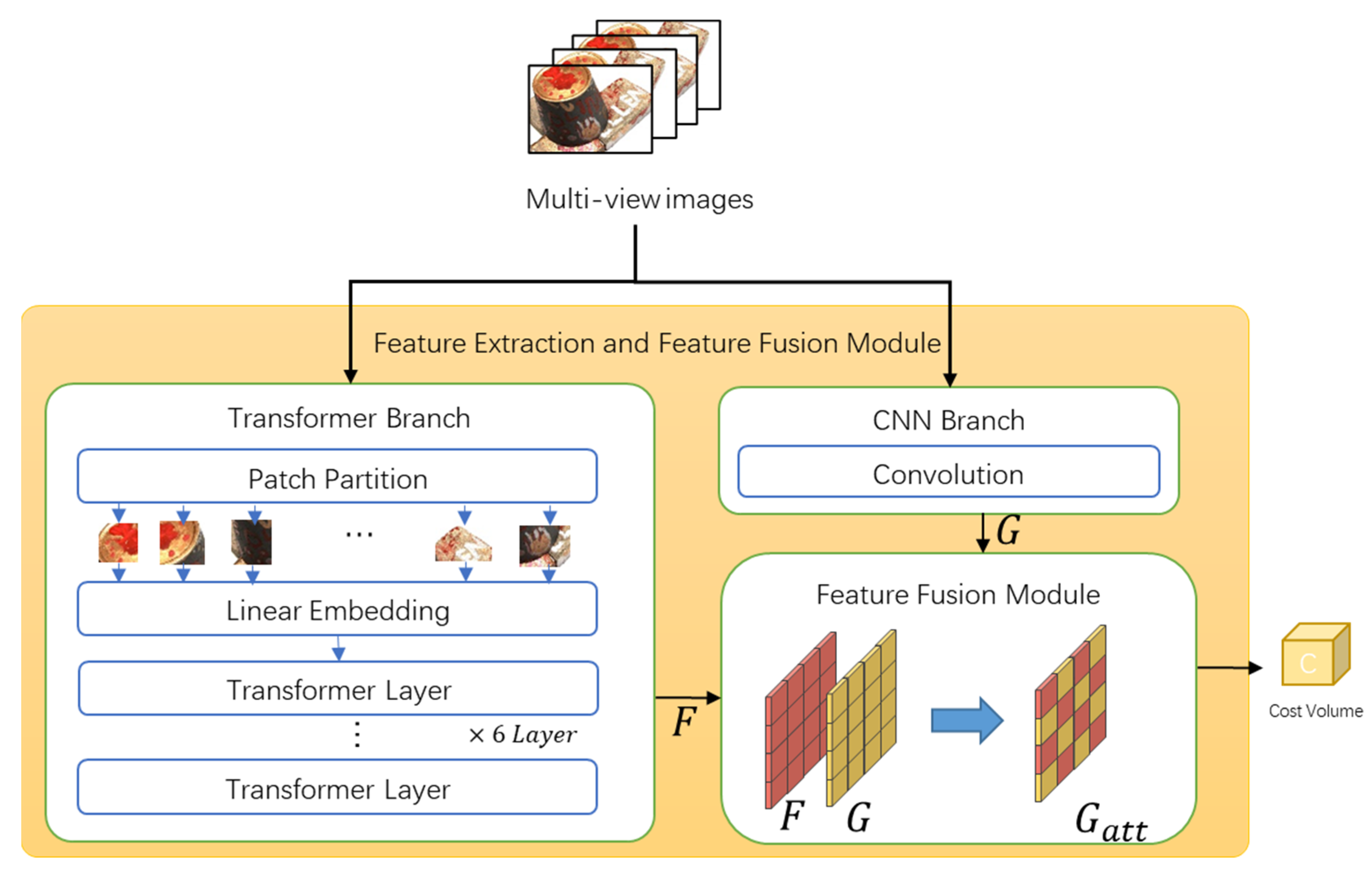
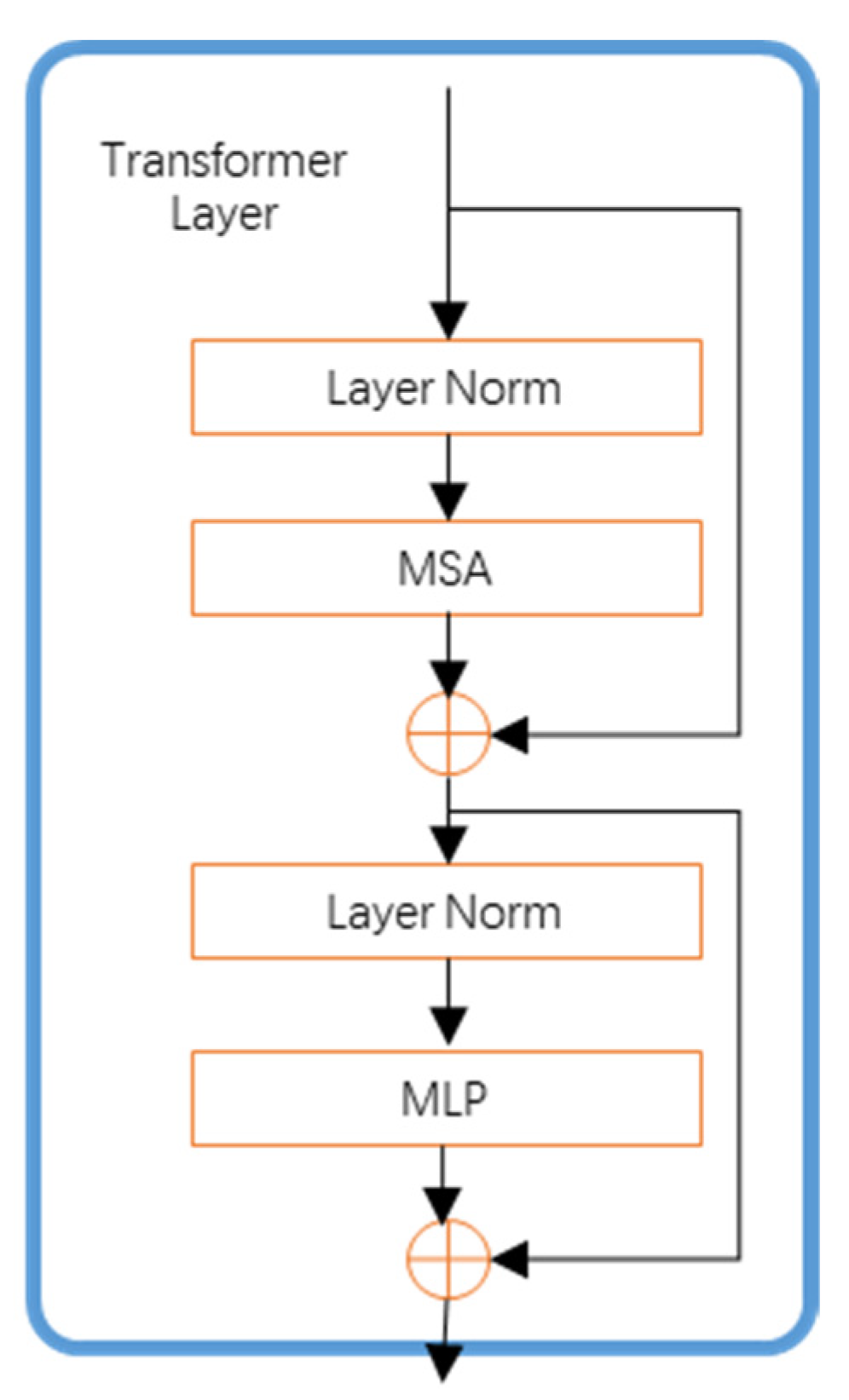
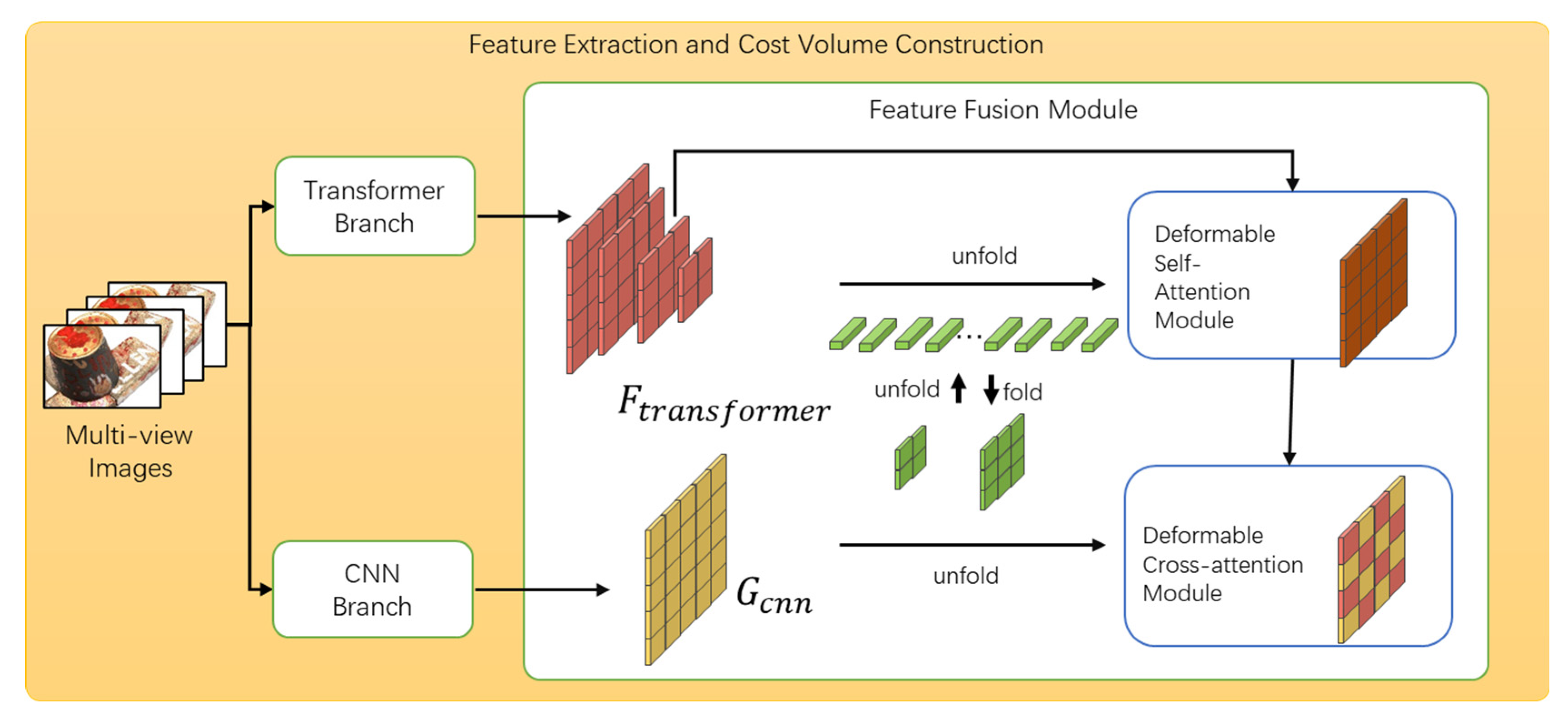
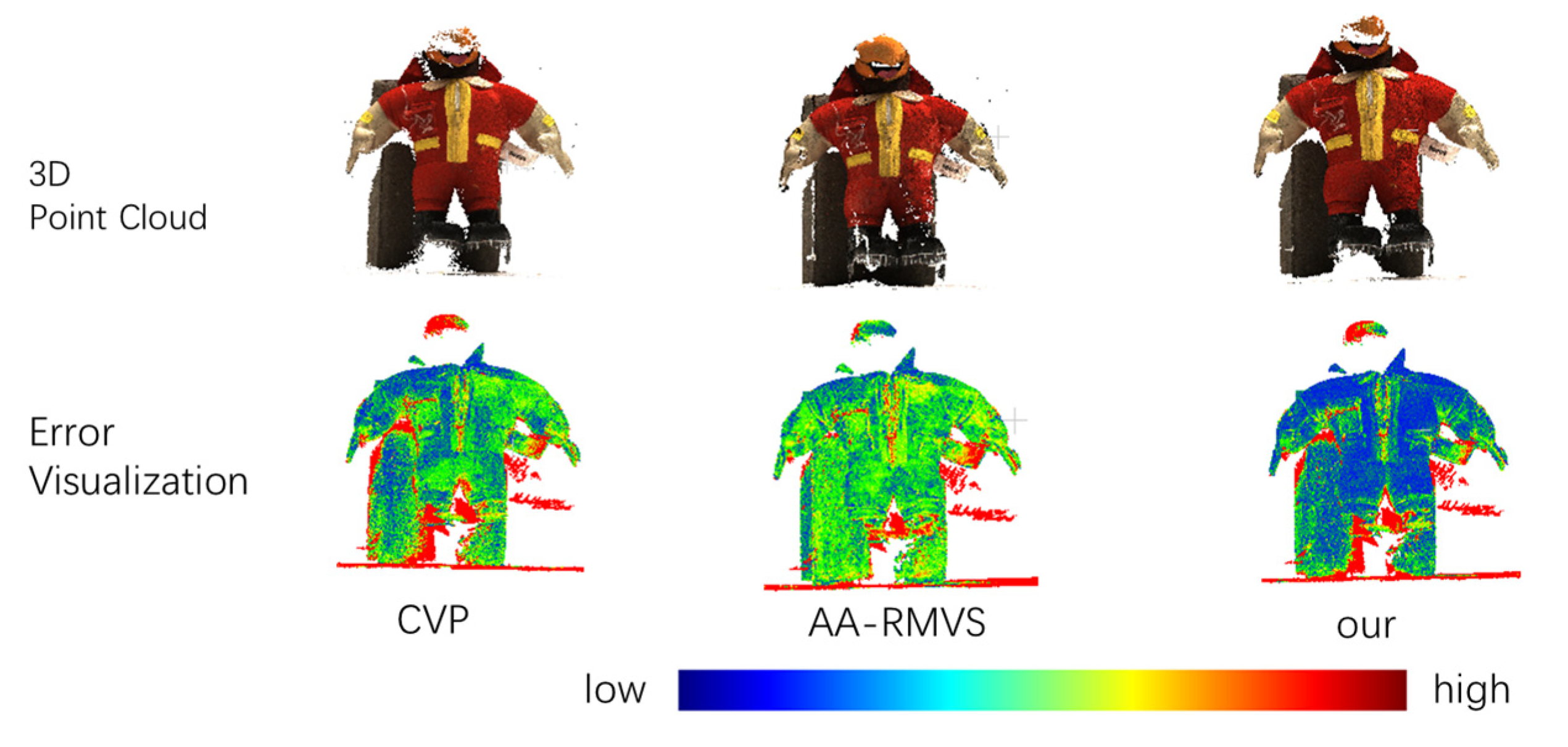

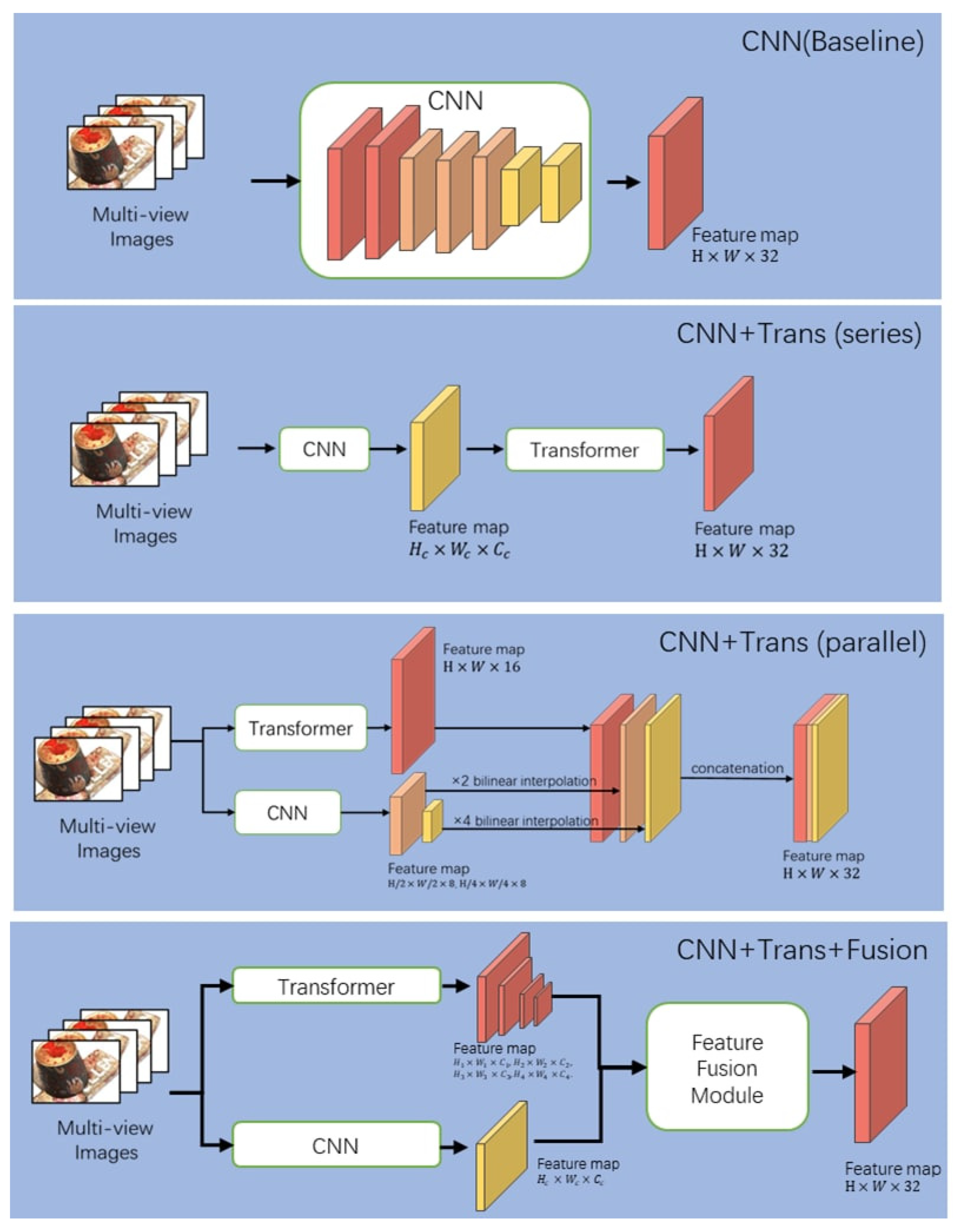
| Model | Regularization Scheme | ||
|---|---|---|---|
| 3D CNN | RNN | Coarse to Fine | |
| MVSNet [5] | √ | ||
| R-MVSNet [6] | √ | ||
| Cas-MVSNet [24] | √ | ||
| CVP-MVSNet [25] | √ | ||
| UCS-Net [26] | √ | ||
| Vis-MVSNet [27] | √ | ||
| PVA-MVSNet [13] | √ | ||
| D2HC-RMVSNet [9] | √ | ||
| AA-RMVSNet [12] | √ | ||
| Model | Acc. | Comp | O.A. |
|---|---|---|---|
| Furu [1] | 0.613 | 0.941 | 0.777 |
| Gipuma [2] | 0.283 | 0.873 | 0.587 |
| COLMAP [3] | 0.400 | 0.664 | 0.532 |
| MVSNet [5] | 0.396 | 0.527 | 0.462 |
| R-MVSNet [6] | 0.385 | 0.459 | 0.422 |
| P-MVSNet [33] | 0.406 | 0.434 | 0.420 |
| D2HC-RMVSNet [9] | 0.395 | 0.378 | 0.386 |
| PointMVSNet [34] | 0.342 | 0.411 | 0.376 |
| Vis-MVSNet [27] | 0.369 | 0.361 | 0.365 |
| Cas-MVSNet [24] | 0.325 | 0.385 | 0.355 |
| CVP-MVSNet [25] | 0.296 | 0.406 | 0.351 |
| AA-RMVSNet [12] | 0.376 | 0.339 | 0.357 |
| IterMVS [35] | 0.373 | 0.354 | 0.363 |
| EMO-MVS [36] | 0.360 | 0.328 | 0.344 |
| MVS2D [37] | 0.394 | 0.290 | 0.342 |
| Our | 0.292 | 0.385 | 0.338 |
| Model | Acc. | Comp | Overall |
|---|---|---|---|
| CNN (Baseline) | 0.416 | 0.427 | 0.421 |
| CNN + Trans (series) | 2.525 | 6.740 | 4.623 |
| CNN + Trans (parallel) | 0.567 | 0.307 | 0.437 |
| CNN + Trans + Fusion | 0.292 | 0.385 | 0.338 |
| MVSNet | 0.396 | 0.527 | 0.462 |
| R-MVSNet | 0.385 | 0.459 | 0.422 |
| Param | Time | Memory | Complexity | |
|---|---|---|---|---|
| Ours | 952 K | 0.85 s | 4.21 GB |
Disclaimer/Publisher’s Note: The statements, opinions and data contained in all publications are solely those of the individual author(s) and contributor(s) and not of MDPI and/or the editor(s). MDPI and/or the editor(s) disclaim responsibility for any injury to people or property resulting from any ideas, methods, instructions or products referred to in the content. |
© 2022 by the authors. Licensee MDPI, Basel, Switzerland. This article is an open access article distributed under the terms and conditions of the Creative Commons Attribution (CC BY) license (https://creativecommons.org/licenses/by/4.0/).
Share and Cite
Gao, R.; Xu, J.; Chen, Y.; Cho, K. Heterogeneous Feature Fusion Module Based on CNN and Transformer for Multiview Stereo Reconstruction. Mathematics 2023, 11, 112. https://doi.org/10.3390/math11010112
Gao R, Xu J, Chen Y, Cho K. Heterogeneous Feature Fusion Module Based on CNN and Transformer for Multiview Stereo Reconstruction. Mathematics. 2023; 11(1):112. https://doi.org/10.3390/math11010112
Chicago/Turabian StyleGao, Rui, Jiajia Xu, Yipeng Chen, and Kyungeun Cho. 2023. "Heterogeneous Feature Fusion Module Based on CNN and Transformer for Multiview Stereo Reconstruction" Mathematics 11, no. 1: 112. https://doi.org/10.3390/math11010112
APA StyleGao, R., Xu, J., Chen, Y., & Cho, K. (2023). Heterogeneous Feature Fusion Module Based on CNN and Transformer for Multiview Stereo Reconstruction. Mathematics, 11(1), 112. https://doi.org/10.3390/math11010112







